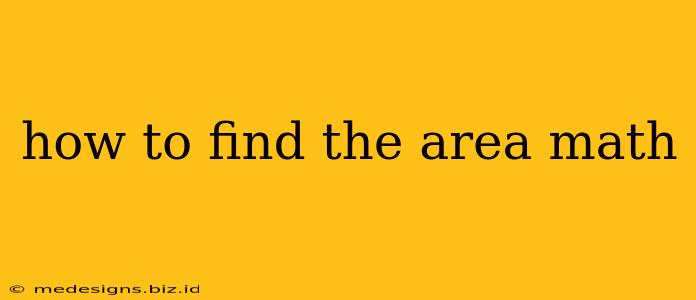Finding the area—a fundamental concept in mathematics—is crucial for numerous applications, from everyday tasks to complex engineering projects. This guide provides a comprehensive overview of how to calculate area for various shapes, offering clear explanations and practical examples. Understanding area calculation empowers you to solve a wide range of problems efficiently.
Understanding Area
Before diving into formulas, let's define area. Simply put, area is the amount of two-dimensional space a shape occupies. It's measured in square units, such as square centimeters (cm²), square meters (m²), or square feet (ft²). The choice of unit depends on the scale of the shape you're measuring.
Calculating Area for Common Shapes
Here's a breakdown of how to find the area of several common geometric shapes:
1. Rectangle
The area of a rectangle is calculated by multiplying its length and width.
Formula: Area = length × width
Example: A rectangle with a length of 5 cm and a width of 3 cm has an area of 5 cm × 3 cm = 15 cm².
2. Square
A square is a special type of rectangle where all sides are equal in length. Therefore, the area is simply the side length squared.
Formula: Area = side × side = side²
Example: A square with sides of 4 inches has an area of 4 inches × 4 inches = 16 square inches.
3. Triangle
The area of a triangle is half the product of its base and height.
Formula: Area = (1/2) × base × height
Example: A triangle with a base of 6 meters and a height of 4 meters has an area of (1/2) × 6 m × 4 m = 12 m². It's important to note that the height must be perpendicular to the base.
4. Circle
The area of a circle is determined using its radius (the distance from the center to any point on the circle) and the mathematical constant pi (π ≈ 3.14159).
Formula: Area = π × radius²
Example: A circle with a radius of 7 cm has an area of π × (7 cm)² ≈ 153.94 cm².
5. Trapezoid
A trapezoid is a quadrilateral with one pair of parallel sides (bases). The area is calculated using the lengths of both bases and the height.
Formula: Area = (1/2) × (base1 + base2) × height
Example: A trapezoid with bases of 5 inches and 9 inches and a height of 4 inches has an area of (1/2) × (5 in + 9 in) × 4 in = 28 square inches.
Beyond Basic Shapes: Irregular Areas
Finding the area of irregular shapes requires more advanced techniques. Methods include:
- Dividing into smaller shapes: Break the irregular shape into several simpler shapes (rectangles, triangles, etc.) whose areas you can calculate individually. Then, add the individual areas together to find the total area.
- Using calculus (integration): For complex curves, calculus provides a precise method to calculate area. This is typically covered in higher-level mathematics courses.
- Numerical methods: Computer programs and software can approximate the area of irregular shapes through numerical methods.
Practical Applications of Area Calculation
Understanding how to find the area has countless real-world applications:
- Construction and Engineering: Calculating the amount of materials needed for flooring, roofing, or painting.
- Land Surveying: Determining property sizes and boundaries.
- Gardening and Landscaping: Planning garden layouts and calculating the amount of fertilizer or mulch needed.
- Manufacturing: Designing and cutting materials for products.
Mastering area calculations provides a solid foundation for various mathematical and practical endeavors. Remember to always double-check your units and ensure you're using the correct formula for the given shape.
